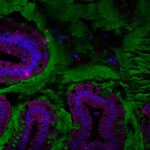Link to Pubmed [PMID] – 35795241
Link to DOI – 10.1093/jacamr/dlac077
JAC Antimicrob Resist 2022 Aug; 4(4): dlac077
Antimicrobial drugs are mostly studied for their impact on emergence of bacterial antibiotic resistance, but their impact on the gut microbiota is also of tremendous interest. In vitro gut models are important tools to study such complex drug-microbiota interactions in humans.The MiniBioReactor Array (MBRA) in vitro microbiota system; a single-stage continuous flow culture model, hosted in an anaerobic chamber; was used to evaluate the impact of three concentrations of a third-generation cephalosporin (ceftriaxone) on faecal microbiota from two healthy donors (treatment versus control: three replicates per condition). We conducted 16S microbiome profiling and analysed microbial richness, diversity and taxonomic changes. β-Lactamase activities were evaluated and correlated with the effects observed in the MBRA in vitro system.The MBRA preserved each donor’s specificities, and differences between the donors were maintained through time. Before treatment, all faecal cultures belonging to the same donor were comparable in composition, richness, and diversity. Treatment with ceftriaxone was associated with a decrease in α-diversity, and an increase in β-diversity index, in a concentration-dependent manner. The maximum effect on diversity was observed after 72 h of treatment. Importantly, one donor had a stronger microbiota β-lactamase activity that was associated with a reduced impact of ceftriaxone on microbiota composition.MBRA can reliably mimic the intestinal microbiota and its modifications under antibiotic selective pressure. The impact of the treatment was donor- and concentration-dependent. We hypothesize these results could be explained, at least in part, by the differences in β-lactamase activity of the microbiota itself. Our results support the relevance and promise of the MBRA system to study drug-microbiota interactions.


